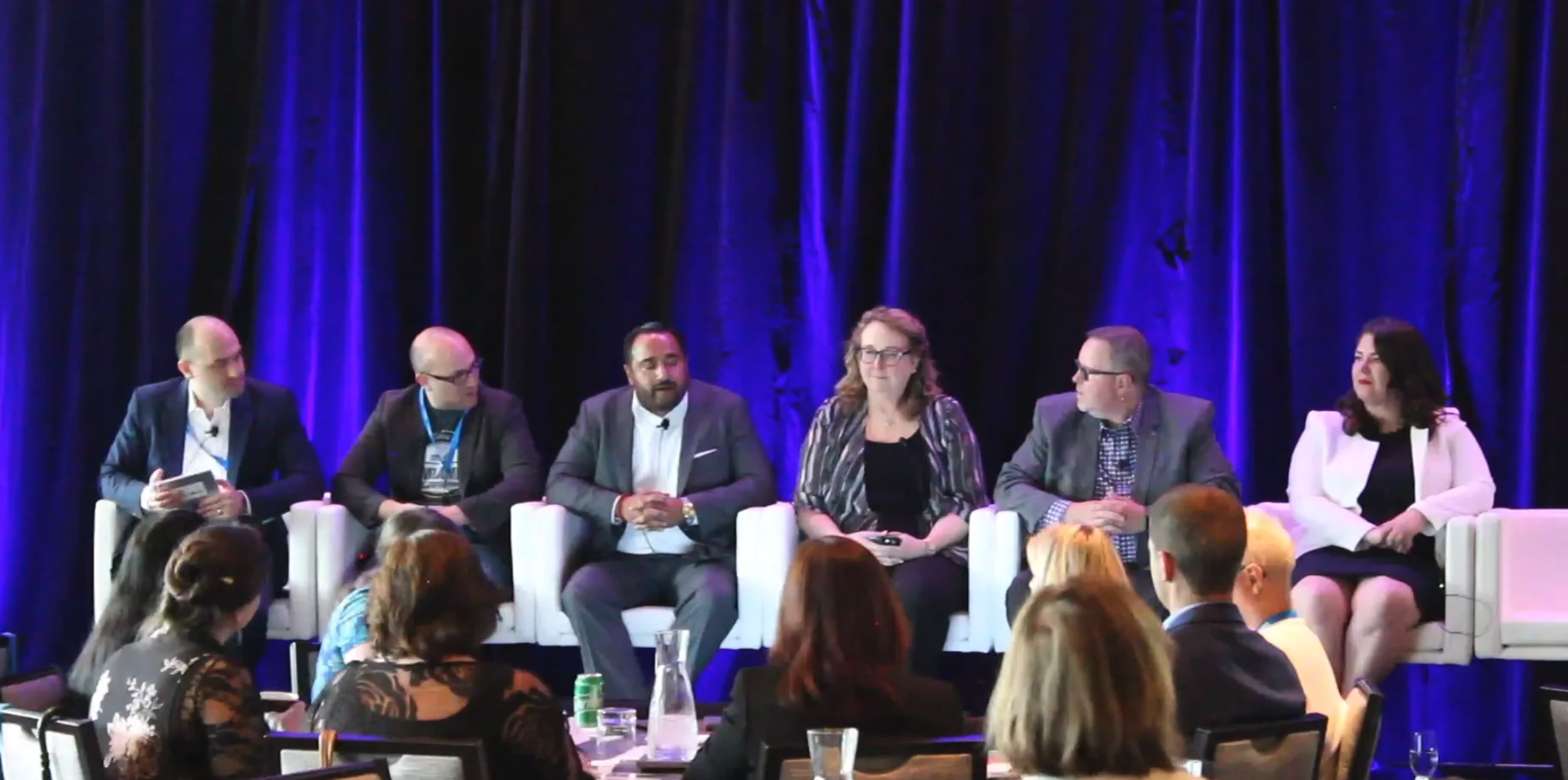Shawnna Sumaoang: Hi and welcome to the Sales Enablement PRO podcast. I am Shawnna Sumaoang. Sales enablement is a constantly evolving space, and we’re here to help professionals stay up to date on the latest trends and best practices so they can be more effective in their jobs.
Today, I’m excited to have Leon join us from SecurityScorecard. Leon, I’d love for you to just introduce yourself, your title, and your organization to our audience.
Leon Hassid: Sure. Thanks for that, Shawnna. First of all, thank you so much for the invitation. It’s a pleasure to be here. So, my name is Leon Hassid and I’ve been working in B2B sales and business development roles for over 15 years now. For the last six months, I’ve been working at SecurityScorecard where I’ve been given the wonderful opportunity, I would say, to bring together two worlds that have been and still are a passion of mine – that’s cybersecurity and sales enablement and training. The latter obviously being the main area of my responsibility. What I do is I basically oversee enablement and training for all client-facing professionals at SecurityScorecard, which includes pre-sales and post-sales, about a hundred people-plus, more or less.
SS: Very cool. I love that you are combining two of your passions in one, and I think I can see a lot of synergy between those two areas. In fact, you were recently included in a list of 100 sales enablement best practices. You had been talking about the best way to measure sales enablement’s impact on the bottom line, and that’s by systematically tracking sales velocities. So, why do you think sales velocity is the most important metric for sales enablement?
LH: Sure. Happy to give some context. Sales velocity is something that’s worked for me in my career, which is the reason why I call it the most important, but it does depend on the business itself, the industry you are operating in, and a lot of other factors. So, there are definitely other KPIs that one could in fact consider as being the most important, but that’s the one that has worked for me.
I think in order to qualify that though, let me just give in my mind what could be a basic definition. Sales velocity is the equation, if you will, that any leader needs to look at to try and capture how fast a business is making money. It looks at how quickly leads are moving and converting through the pipeline. How much value new customers or new logos, if you will, are providing over a given period of time. And it depends on what kind of period you’re looking at. So, in practical terms, if you think about it, the less time it takes for a prospect to move through the pipe right from the beginning all the way to the end, the faster you close more deals. In simple terms, a higher sales velocity means you’re bringing in more revenue in less time, which is a dream world in my mind. So, tracking that over time allows you to benchmark your sales velocity against other teams.
Let’s say I’m managing an inside sales team and I want to look at our velocity vis-a-vis a field to team. You are able to compare the performance or the effectiveness, if you will, of individual reps against one another or different regions and also see how changes to the sales process are impacting the business for better or worse. What I’ve also done in the past is you can use it for more accurate forecasting and determine how the sales process you have in place can be optimized for faster sales and higher conversions.
The reason why I think is the most important metric is because it allows me to always think in terms of the initiatives of programs that I need to consider that can have a direct impact on the company’s ability to frankly, make money and make money faster. And it’s because it’s based on the KPIs that the business is measuring regularly anyway, and I know we’ll go into that later. It’s easier for people in sales enablement leadership roles to just show their value to their business, on a continuous basis.
SS: Absolutely, absolutely. And I think you’re spot on. I think sales velocity is kind of one of those leading indicators, that sales enablement can measure to understand where they can have really significant impact in real-time. To your point, today’s business is just moving at such a more rapid clip than it ever was before. So, how do you go about measuring sales velocity and how do you correlate that as best as possible back to sales enablement efforts specifically?
LH: Sure. Happy to do that. There are four factors that affect sales velocity. It’s basically an equation: the number of opportunities that you have in your pipeline, the average deal size or what the SaaS industry may be calling average selling price. So, ASP, your conversion rate, and that’s typically what businesses would call their win rate. And of course, last but not least, how long it takes for a sale to actually close, so the duration of your sales cycle, to calculate sales velocity.
There’s really only one formula. You basically multiply your opportunities created in a period by your area’s speed, and then by your close rate, and you divide all of that by your sales cycle, measured over the duration that you’re looking to calculate sales velocity for. So, if you want to do it in days, you should divide by the number of days on the average that it takes for you to close a particular deal. The important point is that these KPIs can be used to calculate velocity over time, hopefully trying to figure out how to optimize any of the elements. And what are the sales enablement program activities that you need to associate with those elements in order to, again, going back to what I mentioned earlier, allow the business to make more money faster.
The beautiful thing about these KPIs, ASP, win rate, etc., all of these things are easy to track using CRM data. So, salesforce.com is the technology we’re using. Any other CRM tool would apply here. Those KPIs are things that a chief revenue officer who wants to take a look at anyway, so it’s more about bringing them together to paint a more complete picture around how much money are we really making on a daily basis, or on a quarterly basis? Whatever you’re looking at.
So, you asked me about correlation, the way you try, or at least I try to correlate or maybe associate, if you will, sales enablement efforts with the improvement in that number, the sales velocity number. One leader only needs to demonstrate how the program or the things that you are doing is impacting any of the four KPIs.
So, let me just give you a quick example. Let’s assume that in Q3 and Q4 of 2020 I want to be able to improve the sales cycle duration and shorten it by 30 days. If you remember these KPIs, this is the denominator in our formula, so a smaller number will actually create a higher velocity. That means that I should be thinking about the things I want to roll out in Q1 and Q2 that will have an impact on that.
Maybe that’s a new set of qualification questions that I train my reps on that allow a deal to move faster. Maybe that’s your new certification process around doing a product demo that looks to educate reps and the new way to position it or maybe a negotiation session where you’re coaching reps on how to get access to an economic buyer faster. You execute on those initiatives, and then quite frankly, you kind of have to wait and let the numbers speak for themselves.
Here’s the problem and the risk that I faced in the past, and there’s not an easy workaround, but it’s just part of the challenge. The leaders need to always keep in mind that there’s a lot of other uncontrollable variables that are impacting the business. So, a leader should be careful when they use the term correlation because it does not mean causation.
A leader that oversees sales enablement programs needs to stay ahead of that by tracking the number diligently for a number of periods. That’s why I recommend looking at it monthly even so that you can start gathering all those data points.
But it’s important to understand that things may be happening in the market that you just cannot control. A competitor may be dropping their prices drastically and your reps may be finding it very hard to close deals quickly. Or the product category you operate in all of a sudden is now subject to procurement reviews, so that extends sales cycles. So, you may be aiming for a shorter sale cycle, but things are happening in the market that you have no control over. It may be impacting your ability to show improvement. So, it’s very important to have your talk track and your story and your narrative very, very, crystal-clear and representative of what’s happening in the market before you go to your senior leadership and claim success.
SS: Absolutely. Now, I want to return to the notion of having to work with executives and getting buy-in. I want to stay on the topic of sales velocity. How do you partner with other departments? I assume that you’re partnering with the likes of sales operations and others to consistently track sales velocity and other performance metrics. Do you have some practical advice to our audience about how best to go about doing that?
LH: Yeah, sure. So, just as you would coach your sales teams to build relationships broad and deep, it’s important for sales enablement to do the same, assess relationships and kind of the internal roles within your organization. This obviously would be sales operations, sales, and marketing, but it could also require relationships with HR, finance, and operations. The broader your relationships within their organizations, the better your chances are of success with the CEO and the senior leadership, especially if you’re part of a startup, let’s say.
So, you need to do your homework, but you nailed it. The relationship with sales operations is pivotal for all intents and purposes. They tend to be the guardians of the data we’re looking to capture. All other things being equal, they also tend to own the tech stack that reps should be using so that they can do their job properly. So, the question is, how am I as a leader enabling the reps to do that?
But to me, relationships with other departments such as product, customer success, and even HR are huge. Those are constituents that you constantly need to educate and convince that the metrics you’re focusing on – so in this case, sales velocity – is the right one. And those departments have their own agenda, their own initiatives, and ultimately sales needs to know about that and be enabled on it.
My advice to your listeners, and this is something I received very early in my career, would be to apply the rules of early consultation. And I know this is not going to be popular. Don’t be afraid of more meetings. Perhaps that’s not what people want to hear, but to me, if you don’t have a regular touchpoint, at least weekly with the leaders in those functions we’ve been talking about, I believe you’re creating unnecessary risk in your sales enablement program.
So, one practical tip that has worked for me in any organization I’ve had the pleasure of being part of is 15-minute bi-weekly touchpoints with the key stakeholders. It’s never hurt anyone. Quite the opposite. It’s helped me build rapport and it’s about building those relationships that will allow you to be successful and be able to drive the initiatives you want to drive forward.
SS: I think that’s fantastic advice. I think you’re right. I think more meetings can often be a hard thing for organizations to digest, but I do think sales enablement, given its highly cross-functional nature, absolutely does have to have a high degree of cross-department communication going on, especially into executive leadership.
So, I’ve got a final question for you, and it’s a little bit of a loaded one, so we might need to take it in two parts. We’ve talked a little bit about alignment, but in sales enablement from my perspective, it’s super important that a lot of what it’s measuring, is able to really closely correlate a lot of it back to tangible business impact. Now, how can sales enablement take that and use it to strengthen the alignment but also gain executive buy-in on some of the
sales enablement initiatives or deliverables? I would love to just close on some advice from you on that front.
LH: Yeah, for sure. Let me perhaps address the executive buy-in because their alignment is typically what I think a person new to owning the sales enablement program would be mostly interested in. I have five tips that I constantly talk about and think about and I’m happy to share these.
So, number one for me, build credibility early. Nothing can better position a new leader for success than a quick win that gets people talking. That could be a suggestion you provided in the context of a deal, or a training you conducted on about sales strategies with some of the newer reps, or a new pitch deck that you created or contributed on that was compelling. Anything that shows impact right from the get-go, you need that before suggesting changes or anything new to that for that matter.
Number two for me – and again, this is something that I learned early in my career as an account manager – as a sales enablement leader, you need to have a plan. That’s a given, but to me, it’s not about the plan. It’s about the planning. Regardless of the organization you’re part of, small, medium, or large, it needs to be a consensus-building exercise, even if it takes you a little bit longer. Even if you are a Series C or D startup, you may think you’re over-engineering stuff naturally. You need to bring constituents around the table. You need to be the facilitator of a conversation where you’re collectively deciding what the sales enablement plan needs to be. And this is where, to me, the magic happens. You’ll be able to hear everyone’s goals from senior leadership to the chief revenue officer and so forth. And that has worked for me in my career thus far.
Another tip that I would have is act as if. This is something I picked up from a movie, and obviously I’m changing the orientation of it. But what I mean by that is you want to act as if you’re in the shoes of other leaders and think about why they should be listening to you. There’s no better way in my mind to gain that alignment you talked about than trying to associate everything you’re doing with other people’s goals.
Let me give you an example. Why would a head of product listen to you if you’re not properly training your reps on the new features? Why would a sales operations leader be willing to partner with you consistently if you’re not supporting the adoption of a new technology that they’ve introduced to their stack? All these things matter, because that’s what people keep in mind. And that’s where you build your brand in people’s perceptions. So, act as if would be definitely something that I would recommend to people listening.
And last but not least, own the outcome. So, we talked about this. Be confident in your ability to have direct impact on the bottom line. Using sales velocity to measure your performance kind of gets you that. So, before you even think about what the tactics may be that you want to introduce to the organization, my recommendation is to commit yourself to driving improvement by making it known firm-wide that that’s the basis of your evaluation.
Sometimes sales enablement leaders have skin in the game, but I don’t think they do a good enough job letting others know about it. It’s more important that a chief revenue officer or a head of sales in the East region of the U.S. knows that. As a sales enablement leader, I’m impacted – even my compensation – by how well their team does on a revenue basis. I feel that builds credibility. It builds accountability. It just allows you to have a different conversation.
SS: Those are some really solid tips. Leon, thank you so much for joining us today. I greatly enjoyed our conversation.
LH: Sure thing, Shawnna. Thanks again for the opportunity.
SS: To our audience, thanks for listening. For more insights, tips, and expertise from sales enablement leaders, visit salesenablement.pro. If there’s something you’d like to share or a topic you’d like to learn more about, please let us know. We’d love to hear from you.







